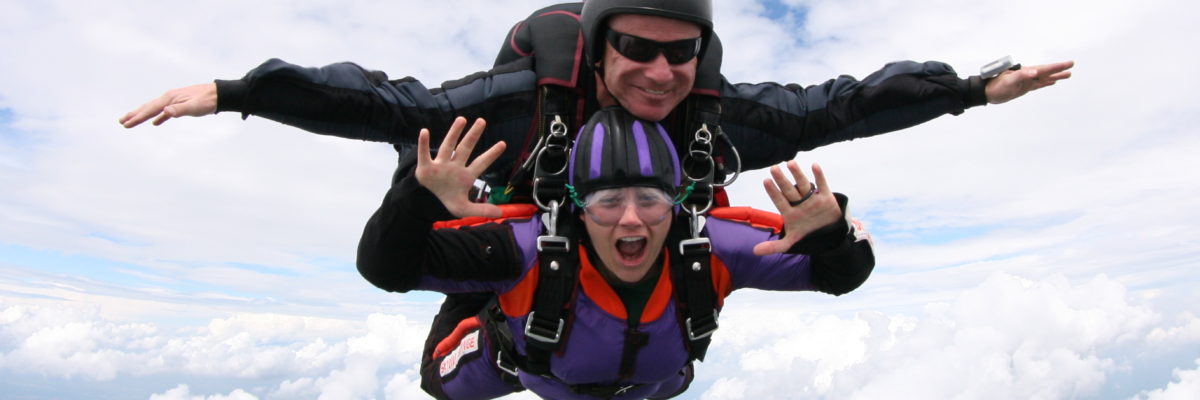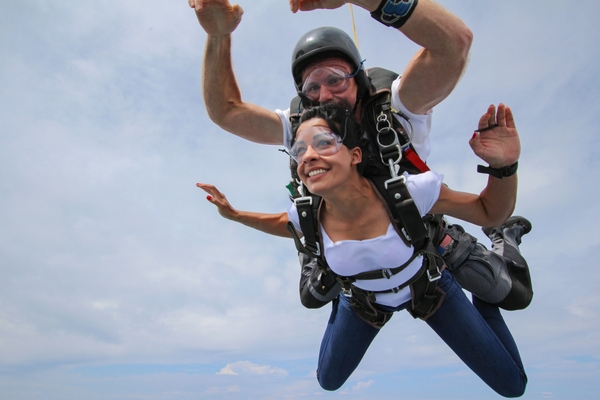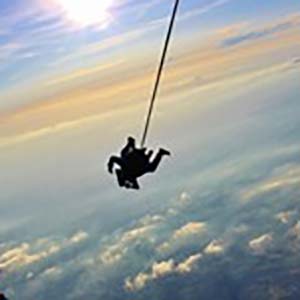
The HALO Tandem Jump
Wednesday, March 13, 2019
- Skydive Orange
- 3/13/19
- 0
- HALO Tandem
Planning your tandem skydiving adventure? Up the ante with a HALO Tandem Jump.
What is HALO Skydiving Anyhow?
High Altitude Low Opening of (HALO) skydiving was initially developed as one of two means of tactical military operations to deliver military personnel, equipment, and supplies by using free-fall from an aircraft at high-altitude and subsequent parachute insertion into contested or enemy-occupied areas. The other, more covert method of parachute insertion is known as High Altitude High Opening (HAHO).
Unlike HAHO, where the parachute is deployed almost immediately upon exiting the aircraft at high altitude. In the HALO method, a jumper exits the aircraft from a high altitude (anywhere from 15,000-35000 feet), experiences freefall reaching terminal velocity, and then deploys their parachute at a lower altitude.
Difference from a Typical Tandem Skydive
What makes a HALO jump any different than a typical tandem skydive? One of the primary differences between a typical tandem skydive and a HALO tandem skydive is altitude. At Skydive Orange, your basic tandem skydiving package gets you 13,500 feet of altitude. This freefall from nearly 14,000feet gets you 60 seconds of adrenaline pumping, terminal velocity pushing fun.
With a HALO tandem skydive, you’ll travel over 3 miles above the earth to 17,500 feet and experience even more of the thrill with nearly 90 seconds of freefall!
Altitude Matters
So, why should you care about skydiving altitude? Well, when it comes to a once-in-a-lifetime experience, don’t you want to get as much bang for your buck as you can?
Like so many of life’s fleeting moments, after your skydive, you will wish you’d had just a few more seconds! More time in freefall means more time to soak it all in: the rush, the fun, and the feeling of sheer invincibility! After all, on a HALO tandem skydive, you’re literally on top of the world.
Supplemental Oxygen
Another thing that sets a HALO skydive apart from a typical tandem skydive is the use of supplemental oxygen.
Ever hear that the air up high is thinner? In a way, this is true. Compared to the air on the ground, or even at 13,500 feet, the air at 17,500 feet is far less dense.
For those of you that might have skipped that physics lecture, here’s the science behind it.
As you increase altitude, pressure decreases. The result is that in any given volume of air there are fewer molecules present. Essentially, there is less oxygen way up there at 17,500 feet to breathe!
The lack of oxygen present in the atmosphere at higher altitudes has to be addressed when making a high altitude skydive. When making a jump from a skydiving altitude of 17,500 feet individuals are required to use supplemental oxygen as a precaution to keep from experiencing something called hypoxia, or in other words, an oxygen deficiency.
And aside from keeping you breathing easy, honestly, there’s nothing to get you feeling quite so ‘Mission Impossible’ as riding an aircraft to 17,500 feet, intermittently sipping oxygen from the sanitized tubes routed throughout the main cabin of the plane until it’s go time. Just the slight setting change makes an already incredible experience all the more epic!
Ready to feel like an action star? Schedule your HALO Tandem Skydive at Skydive Orange today!
The largest tandem skydiving center near Northern Virginia, Washington D.C. and Maryland.
Copyright © 2025, Skydive Orange, All Rights Reserved.
DropZone Web Design & Marketing by Beyond Marketing, LLC



